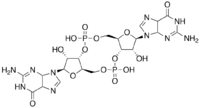Cyclic di-GMP
 | |
| Names | |
|---|---|
| Other names
Cyclic diguanylate; 3',5'-Cyclic diguanylic acid; c-di-GMP; 5GP-5GP | |
| Identifiers | |
| 61093-23-0 | |
| 3D model (Jmol) | Interactive image |
| ChemSpider | 4883312 |
| PubChem | 6323195 |
| |
| |
| Properties | |
| C20H24N10O14P2 | |
| Molar mass | 690.09 g/mol |
| Except where otherwise noted, data are given for materials in their standard state (at 25 °C [77 °F], 100 kPa). | |
| | |
| Infobox references | |
Cyclic di-GMP (also called cyclic diguanylate and c-di-GMP) is a second messenger used in signal transduction in a wide variety of bacteria.[1] Cyclic di-GMP is not known to be used by archaea, and has only been observed in eukaryotes in Dictyostelium.[2] The biological role of cyclic di-GMP was first uncovered when it was identified as an allosteric activator of a cellulose synthase found in Gluconacetobacter xylinus in order to produce microbial cellulose.[3]
In structure, it is a cycle containing only two guanine bases linked by ribose and phosphate.
In bacteria, certain signals are communicated by synthesizing or degrading cyclic di-GMP. Cyclic di-GMP is synthesized by proteins with diguanylate cyclase activity. These proteins typically have a characteristic GGDEF motif, which refers to a conserved sequence of five amino acids. Degradation of cyclic di-GMP is effected by proteins with phosphodiesterase activity. These proteins have either an EAL or an HD-GYP amino acid motif. Processes that are known to be regulated using cyclic di-GMP, at least in some organisms, include biofilm formation, motility and induction of virulence factors.
Cyclic di-GMP levels are regulated using a variety of mechanisms. Many proteins with GGDEF, EAL or HD-GYP domains are found with other domains that can receive signals, such as PAS domains. Enzymes that degrade or synthesize cyclic di-GMP are believed to be localized to specific regions of the cell, where they influence receivers in a restricted space.[1] In Gluconacetobacter xylinus c-di-GMP stimulates the polymerization of glucose into cellulose as a high affinity allosteric activator of the enzyme cellulose synthase.[4] Some diguanylate cyclase enzymes are allosterically inhibited by cyclic di-GMP.
Cyclic di-GMP levels regulate other processes via a number of mechanisms. The Gluconacetobacter xylinus cellulose synthase is allosterically stimulated by cyclic di-GMP, presenting a mechanism by which cyclic di-GMP can regulate cellulose synthase activity. The PilZ domain has been shown to bind cyclic di-GMP and is believed to be involved in cyclic di-GMP-dependent regulation, but the mechanism by which it does this is unknown. Recent structural studies of PilZ domains from two bacterial species have demonstrated that PilZ domains change conformation drastically upon binding to cyclic di-GMP.[5][6] This leads to the strong inference that conformational changes in PilZ domains allow the activity of targeted effector proteins (such as cellulose synthase) to be regulated by cyclic di-GMP. Riboswitches called the cyclic di-GMP-I riboswitch and cyclic di-GMP-II riboswitch regulate gene expression in response to cyclic di-GMP concentrations in a variety of bacteria, but not all bacteria that are known to use cyclic di-GMP.
See also
References
- 1 2 Tamayo R, Pratt JT, Camilli A (2007). "Roles of cyclic diguanylate in the regulation of bacterial pathogenesis". Annu. Rev. Microbiol. 61: 131–48. doi:10.1146/annurev.micro.61.080706.093426. PMC 2776827
 . PMID 17480182.
. PMID 17480182. - ↑ Chen ZH, Schaap, P (2012). "The prokaryote messenger c-di-GMP triggers stalk cell differentiation in Dictyostelium". Nature. 488: 680–683. doi:10.1038/nature11313. PMC 3939355
 . PMID 22864416.
. PMID 22864416. - ↑ P. Ross, H. Weinhouse; Y. Aloni, D. Michaeli; P. Weinberger-Ohana, R. Mayer; S. Braun, E. de Vroom; G. A. van der Mare; J. H. van Boom & M. Benziman (1987). "Regulation of cellulose synthesis in Acetobacter xylinum by cyclic diguanylic acid". Nature. 325 (6101): 279–81. doi:10.1038/325279a0. PMID 18990795.
- ↑ Regulation of cellulose synthesis in Acetobacter xylinum by cyclic diguanylic acid P. Ross Nature, 1987
- ↑ Benach, J; Swaminathan, SS; Tamayo, R; Handelman, SK; Folta-Stogniew, E; Ramos, JE; Forouhar, F; Neely, H; Seetharaman, J (2007). "The structural basis of cyclic diguanylate signal transduction by PilZ domains". The EMBO Journal. European Molecular Biology Organization. 26 (24): 5153–5166. doi:10.1038/sj.emboj.7601918. PMC 2140105
 . PMID 18034161.
. PMID 18034161. - ↑ Junsang K; Kyoung-Seok R; Henna K; Jae-Sun S; Jie-Oh L; Chaejoon C; Byong-Seok C (23 April 2010). "Structure of PP4397 reveals the molecular basis for different c-di-GMP binding modes by Pilz domain proteins". Journal of Molecular Biology. 398 (1): 97–110. doi:10.1016/j.jmb.2010.03.007. PMID 20226196.